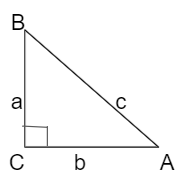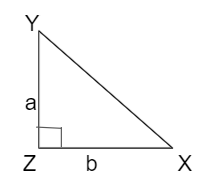The converse of Pythagoras theorem is related to the right-angled triangles. It states that if the square of a side is equal to the sum of the squares of the remaining two sides, the triangle is the right-angled triangle. Here we are giving the proof, examples, formula, applications and problems related to the converse of Pythagoras’ theorem.
What is the Converse of Pythagoras’ Theorem?
The converse of Pythagoras theorem statement is in a triangle, if the square of one side is equal to the sum of the squares of the other two sides, then the angle opposite to the first side is a right angle and the triangle is called a right-angled triangle.
Pythagorean theorem states that the sum of the squares of the two legs is equal to the square of the hypotenuse of a right-angled triangle. And it can also be stated as if this relation satisfies, then it is a right-angled triangle. If the sides of the triangle are a, b, c and the condition is a² + b²= c², then the triangle is a right-angled triangle.
The converse of Pythagoras theorem formula is a² = b² + c².
Where,
a, b, c are the sides of the right-angle triangle.
Also, Check:
- AA Criterion of Similarly on Quahttps://ccssanswers.com/drilateral
- Criteria of Similarity between Triangles
The Converse of Pythagorean Theorem Proof
Statement: If the length of the triangle is a, b, c and c² = a²+ b², then the triangle is a right-angled triangle.

Proof:
Draw a triangle XYZ, such as XZ = AC = b and BC = YZ = a.

In △XYZ, by Pythagoras Theorem:
XY² = XZ² + YZ² = b² + a² …………(1)
In △ABC, by Pythagoras Theorem:
AB² = AC² + BC² = b² + a² …………(2)
From equations (1) and (2), we have;
XY² = AB²
XY = AB
△ABC ≅ △XYZ (By SSS postulate)
∠G is the right angle
Thus, △XYZ is a right triangle.
Hence, we can say that the converse of Pythagorean theorem also holds.
Hence Proved.
Questions on Converse of Pythagoras’ Theorem
Question 1:
The sides are the triangle are 7, 11, and 13. Check whether the given triangle is a right triangle or not?
Solution:
Given that,
a = 7, b = 11, c = 13
By using the converse of Pythagoras’ theorem
c² = a² + b²
13²= 7²+ 11²
169 = 49 + 121
169 = 170
So, it is not satisfied with the above equation.
Therefore, the given triangle is not a right triangle.
Question 2:
If the sides of a triangle are in the ratio 13:12:5, prove that the triangle is a right triangle. Also, state which angle is the right triangle.
Solution:
Let the trinagle be ABC
The sides are AB = 12k, BC = 5k, AC = 13k
AB²+ BC² = (12k)² + (5k)²
= 144k² + 25k²
= 169k²
= (13k)²
= AC²
Therefore, by the converse of Pythagoras theorem, ABC is a right-angled triangle in which ∠B = 90°.
Question 3:
The side of a triangle is of length 8 cm, 15 cm and 17 cm. Is this triangle a right triangle? If so, which side is the hypotenuse?
Solution:
Given that,
a = 15 cm, b = 8 cm, c = 17 cm
According to the converse of Pythagoras theorem,
c² = a² + b²
17² = 15² + 8²
289 = 225 + 64
289 = 289
As the condition is satisfied. The triangle is a right-angled triangle.
The hypotenuse is the longest side. So, it is 17 cm.
FAQ’s on Converse of Pythagorean Theorem
1. What is the difference between the Pythagorean theorem and its converse?
The Pythagoras theorem is used to find the length of the missing side of a right triangle. Whereas the converse of the Pythagoras theorem is used to find if the triangle is a right-angled triangle or not.
2. How to find a hypotenuse?
The hypotenuse is the longest side of the right triangle or it is the side that is opposite to the 90 degrees of a triangle. From the Pythagoras theorem, hypotenuse = √[(base)² + (perpendicular)²].
3. What are the applications of the converse of Pythagora’s theorem?
The converse of Pythagora’s theorem is used to find whether the measurements of a triangle belong to the right triangle or not. You can also determine, three sides form a Pythagorean triplet.